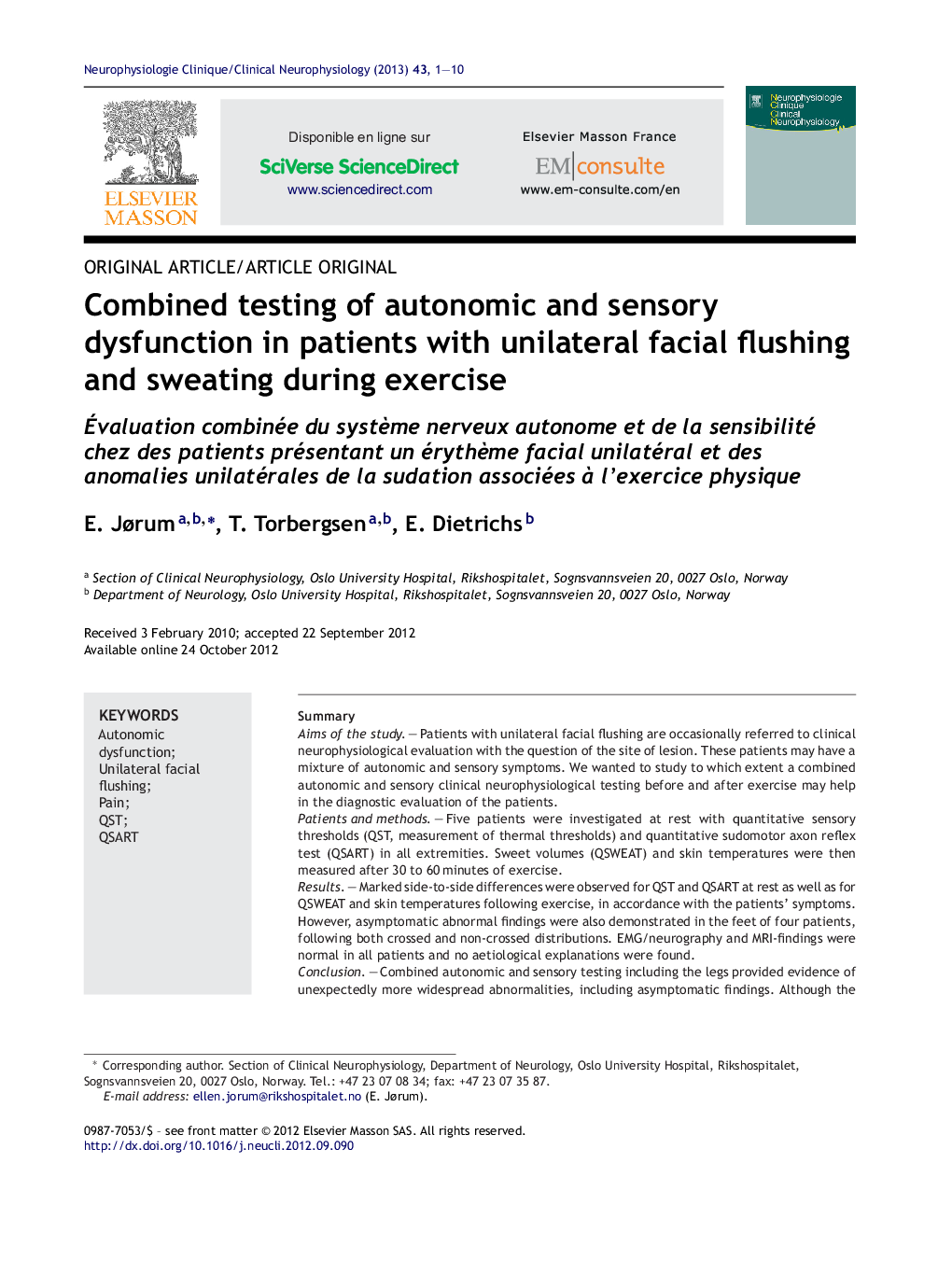| Article ID | Journal | Published Year | Pages | File Type |
|---|---|---|---|---|
| 3082789 | Neurophysiologie Clinique/Clinical Neurophysiology | 2013 | 10 Pages |
SummaryAims of the studyPatients with unilateral facial flushing are occasionally referred to clinical neurophysiological evaluation with the question of the site of lesion. These patients may have a mixture of autonomic and sensory symptoms. We wanted to study to which extent a combined autonomic and sensory clinical neurophysiological testing before and after exercise may help in the diagnostic evaluation of the patients.Patients and methodsFive patients were investigated at rest with quantitative sensory thresholds (QST, measurement of thermal thresholds) and quantitative sudomotor axon reflex test (QSART) in all extremities. Sweet volumes (QSWEAT) and skin temperatures were then measured after 30 to 60 minutes of exercise.ResultsMarked side-to-side differences were observed for QST and QSART at rest as well as for QSWEAT and skin temperatures following exercise, in accordance with the patients’ symptoms. However, asymptomatic abnormal findings were also demonstrated in the feet of four patients, following both crossed and non-crossed distributions. EMG/neurography and MRI-findings were normal in all patients and no aetiological explanations were found.ConclusionCombined autonomic and sensory testing including the legs provided evidence of unexpectedly more widespread abnormalities, including asymptomatic findings. Although the patients presented with seemingly similar symptoms, there was a striking heterogeneity in their results, suggesting different sites of dysfunction. An extracranial lesion was considered likely in one or maybe two patients, while the possibility of a central lesion had to be considered in the three other patients.
RésuméObjectifsIl arrive qu’une exploration neurophysiologique soit demandée chez des patients présentant un érythème unilatéral du visage. Les mécanismes à l’origine de tels dysfonctionnements ne sont pas toujours clairs. Dans cet article, nous tenterons d’examiner la physiopathologie des anomalies vasomotrices et de la sudation ainsi que de troubles sensitifs observés chez cinq patients présentant un érythème unilatéral du visage.Patients et méthodesDes mesures des Quantitative Sensory Testing (« QST » : tests quantitatifs de la sensibilité) et des Quantitative Sudomotor Axon Reflex Test (« QSART » : test sudo-moteur) sont d’abord réalisées au repos. Ensuite, des mesures du volume de sueur (QSWEAT) et de la température cutanée à plusieurs endroits sont réalisées après un exercice physique de 30 à 60 minutes (jogging ou monter/descendre des escaliers à grande vitesse).RésultatsAu repos, de grandes différences entre les deux côtés du corps, y compris au niveau des pieds, étaient identifiées au moyen des QST et QSART chez trois patients. Après l’exercice physique, de grandes différences de QSWEAT et de températures cutanées ont également été retrouvées entre les deux côtés du corps, non seulement au niveau du visage, mais également des extrémités, selon une distribution croisée ou non-croisée. Aucune pathologie n’a été retrouvée à l’IRM.ConclusionLa combinaison de tests de la sensibilité et d’évaluations du système autonome permet la mise en évidence d’anomalies asymptomatiques chez des patients présentant un érythème unilatéral du visage. Elle démontre que ces patients forment un groupe hétérogène au sein duquel le dysfonctionnement du système nerveux autonome est probablement plus complexe que prévu.
